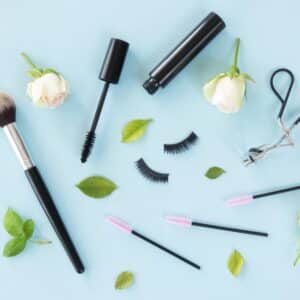Safety is not only a legal obligation, but also super important for consumer confidence. Especially with eye cosmetics such as mascara and eyebrow products, you have to be extra careful. The eyes are one of the most sensitive parts of the body and thus can easily become irritated, cause allergic reactions and contract bacteria.
In the EU, no cosmetic product may be placed on the market without a Cosmetic Product Safety Report (CPSR), in accordance with Regulation (EC) No. 12/23/2009. Even stricter requirements apply to mascara and eyebrow products, as they fall under microbiological risk category 1. In this article, you will learn why additional safety measures are needed, how to prepare a cosmetics safety report and the role of the latest SCCS guidelines in a successful CPSR for makeup.
The growing eye cosmetics market
Mascara and eyebrow products have become part of the daily beauty routine. From eyebrow gels and pencils to mascaras that make your eyelashes fuller or longer, millions of people in Europe use these products every day. Because of this frequent use, mascara and eyebrow makeup are one of the best-selling categories on the cosmetics market.
But while the growing eye cosmetics market presents opportunities for brands and do-it-yourself makers, it also comes with a great responsibility. Because these products are applied directly around the eyes and often several times a day, the risk of microbial growth, irritation or even infection is greater than with other cosmetics, such as body lotions or perfumes.
Therefore, extra care must be taken in preparing a CPSR for mascara and eyebrow products. A standard assessment is not enough here. Each recipe must be thoroughly tested and a detailed cosmetic safety report must be prepared, carefully evaluating all ingredients, preservatives, applicators and packaging.
For manufacturers and DIY makers working with CPSR for makeup, this means that eye products must always be developed according to the highest EU safety standards. This is the only way to ensure that creative formulas are not only attractive, but also safe for everyday use.
Why do eye cosmetics fall into microbiological category 1?
Eye cosmetics automatically belong to the strictest microbiological category in the EU: category 1. This is because the eyes are extremely susceptible to infections and irritations. According to ISO 17516, very low limits apply to these products:
- ≤ 100 CFU/g or ml of bacteria
- ≤ 10 CFU/g or ml yeasts and fungi
- Complete absence of Pseudomonas aeruginosa, Candida albicans and Staphylococcus aureus
These strict standards are necessary. Consider mascara: every time the brush is inserted back into the tube, bacteria from the skin or eyelashes can enter the product. Without preservatives or clever packaging techniques, contamination would quickly occur. The same goes for eyebrow gels or pomades, which often come in contact with the skin several times a day.
Therefore, a cosmetics safety report preparation must demonstrate that the formula remains stable and protected not only throughout its shelf life but also during the post-opening period (PAO). For DIY makers experimenting with mascara making, this means that hygiene and preservation must be part of the recipe from the first moment.
Key concerns in a CPSR
When preparing a mascara and eyebrow products CPSR, there are a few critical components that you need to pay extra attention to.
1. Microbiological preservation and challenge testing.
Producers and DIY makers must show that their formula is resistant to contamination. A challenge test (PET) is performed by deliberately contaminating the product with microorganisms and measuring how effectively the preservative eliminates them. For eye cosmetics, this is a mandatory component.
2. Hygiene of applicators
The packaging and applicator play as big a role as the formula. A mascara brush can easily transmit bacteria. Therefore, a CPSR should consider packaging design (airtight closures, strong lashes) and clear PAO labeling, such as “6M” or “12M.” In professional settings, such as salons, it may be necessary to use disposable applicators.
3. Toxicological assessment of ingredients.
A safety reviewer takes a thorough look at the ingredients.
- Only pigments allowed in Annex IV of the EU Regulation may be used.
- Preservatives must be effective but also safe around the eyes.
- Impurities, such as heavy metals in pigments, must be below established limits.
For DIY, this means that when making mascara or developing eyebrow products, you should always use cosmetically approved pigments and oils.
Step-by-step preparation of a CPSR for eye makeup
A CPSR for makeup consists of two parts:
- Part A: Safety information: formula, ingredients, stability, microbiological quality, packaging.
- Part B: Safety assessment: toxicological profiles, margin of safety (MoS), and a final conclusion by an expert.
Preparation proceeds step by step:
- Check the formula: Compare all raw materials with the EU Annexes (II-VI).
- Perform microbiological tests: Challenge tests and simulations of repeated use are mandatory.
- Evaluate packaging and applicators: Compatibility, migration, and hygiene should be tested.
- Compile Part A: Collect all technical documentation and test results.
- Prepare Part B: A safety evaluator creates toxicological profiles and calculates the MoS.
- Determine shelf life and PAO: Based on stability data and field tests.
- Manage variations: Color changes sometimes fall under the same CPSR, but changes in packaging or preservatives usually require a new report.
- Check the PIF: The Product Information File must be complete before the product can be marketed.
This may be complicated for DIY makers, but by working with reliable pigments, base oils and safe packaging right from the start, you reduce the risk of having to adjust your formulas later and lay a solid foundation for a successful mascara and brow products CPSR.
The role of the SCCS guidelines (12th revision).
One of the most important resources for anyone preparing a CPSR is the SCCS Guidelines, 12th revision. These outline the latest techniques for assessing cosmetic ingredients and help ensure that products comply with EU safety regulations.
They place more emphasis on new approaches (NAMs), such as computational models and in vitro tests, than on animal testing. The threshold toxicological concern (TTC) and iTTC are two tools that help estimate safe exposure levels when insufficient data are available. The guidelines also introduce Next Generation Risk Assessment (NGRA) frameworks, which provide a more comprehensive picture of product safety.
Adhering to SCCS guidelines makes safety ratings for mascaras and eyebrow products stronger and more transparent. For brands and DIY makers alike, this means that a mascara and eyebrow products CPSR not only meets EU requirements, but also shows that the formula has been carefully tested. In this way, a professional cosmetics safety report preparation becomes visible to consumers and builds extra trust. Ultimately, this helps your homemade creations meet the high standards of an official makeup CPSR.
Frequently Asked Questions
V1. Does each color of mascara need its own CPSR?
Not always. The same CPSR may apply if only the pigment changes and it has already been evaluated for safety. However, a new CPSR is required if the composition, applicator or preservative system changes.
V2. What microbiological limits apply to eyebrow and mascara products?
These products must contain ≤ 100 CFU/g bacteria, ≤ 10 CFU/g yeasts and fungi and be completely free of designated pathogens to be classified as category 1 cosmetics.
V3. How can I make sure the applicator is clean?
Through a combination of consumer labeling (such as PAO symbols), efficient preservatives and airtight packaging. Single-use applicators are recommended in professional settings.
V4. Who can draft a CPSR?
According to EU legislation, the report must be prepared and signed only by a qualified safety assessor, usually a specialist in toxicology, microbiology or a related field.
V5. What is the function of the SCCS directive?
Guidelines and procedures for assessing the safety of ingredients are described in the SCCS guidelines. In line with EU standards, they support evaluators in applying consistent, scientifically sound evaluations.
Conclusion
Mascara and eyebrow products are high-risk products and therefore fall into the strictest category of EU cosmetics legislation. Careful cosmetics safety report preparation is mandatory to ensure safety. For DIY makers venturing into mascara making, this means paying attention to ingredients, hygiene and packaging from the start.
At YouWish you will find everything you need: safe pigments, high-quality oils and waxes, and hygienic packaging and applicators. So you can combine your creativity with safety and develop products that are not only beautiful, but also meet the requirements of a professional mascara and eyebrow products CPSR and a full makeup CPSR.

